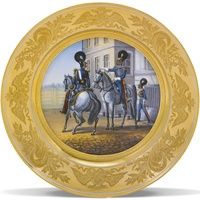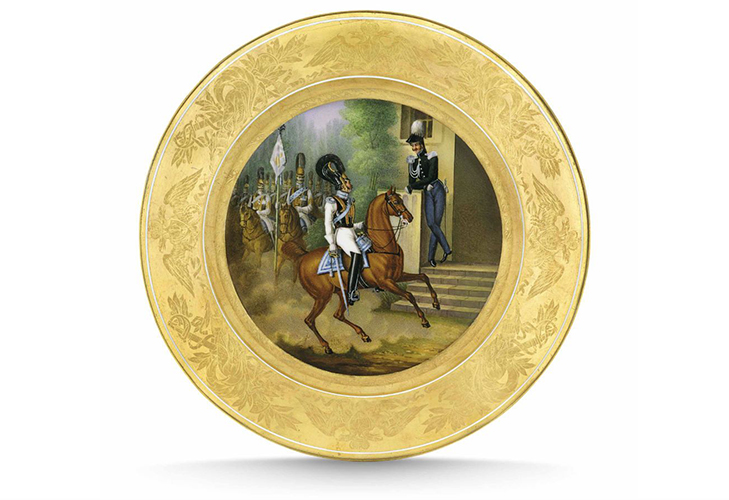Русский фарфор XIX века – это, прежде всего, военная тематика
Военная тематика

Военная тематика
Русский фарфор XIX века – это, прежде всего, военная тематика. Сервизы, декоративные вазы и тарелки, пласты и скульптура использовались для воспевания побед в многочисленных боевых кампаниях того времени. Россия то и дело вступала в борьбу за пограничные территории и это нашло отражение в национальном искусстве. «Первую скрипку» в создании продукции военной тематики играл Императорский завод. В 1810 году, когда война с Наполеоном стала неизбежной, в ассортименте предприятия появились тарелки с батальными сценами, поражавшие тонкостью росписи, реалистичностью и тщательностью деталировки. Особое внимание уделялось обмундированию и экипировке офицеров разных полков, его передавали с исторической точностью.

Отдельная серия была посвящена выдающим полководцам и героям войны 1812 года: Кутузову. Багратиону, Платову, Давыдову. Их изображали не только на декоративных тарелках или пластах, но и на обеденных сервизах. А вот парадные вазы украшали портретами правящих императоров в окружении военной символики – оружия, аллегорических фигур Славы и Победы. Лучшие образцы батальной живописи создал в 1820-х годах приглашённый из Севра художник Жан-Франсуа Свебах. Более поздние российские копиисты ориентировались на его манеру письма. Хорошим подспорьем для них стало и выпущенное в 1840 году графическое издание, посвящённое армейской форме эпохи Николая I и Александра I.
«Военные тарелки» выпускались несколькими сериями:
Название серии / Год начала выпуска / Краткое описание:
Белая - Конец 1820-х - Известна только по архивным документам,
Золотая -1828 - В настоящее время являются редкостью.
Синяя - 1830
Бирюзовая - 1838 - Самая массовая серия.
Коричневая - 1850 - Отразила реформу Александра II, которая привела к изменению кроя военного мундира.
Тарелки военных серий ИФЗ служили украшением дворцовых залов и лишь изредка использовались по назначению на парадных полковых обедах. Благодаря этому, они великолепно сохранились и высоко ценятся коллекционерами. Одна из таких тарелок была продана в 2015 году на аукционе Christie’s за $80 500. Эксклюзивные предметы военных серий доступны не всем. Однако можно полнить коллекцию недорогими ординарными тарелками, которые выпускались большими партиями – до 800 штук в месяц.

